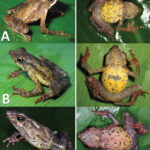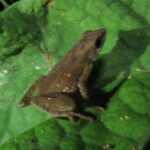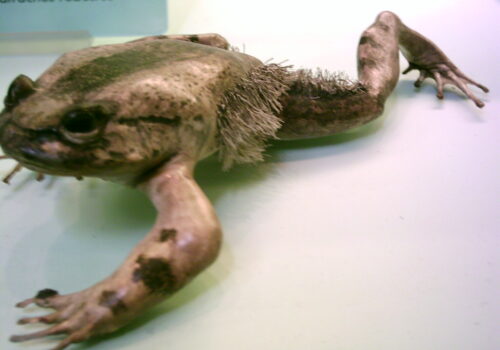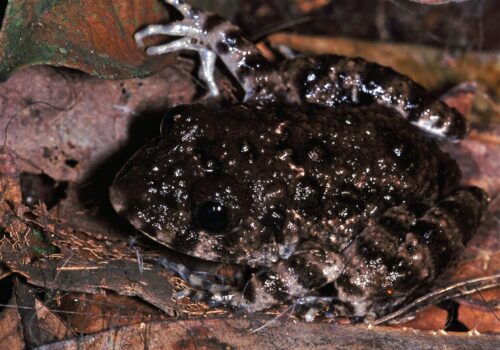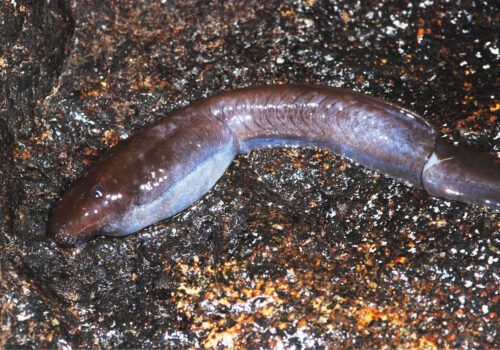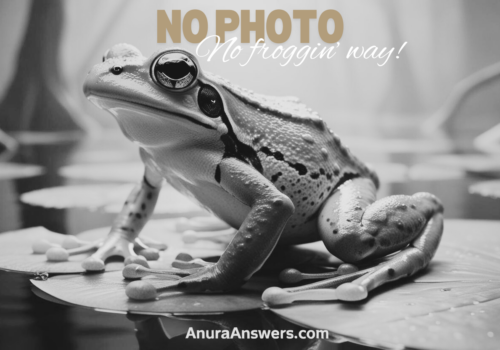Leptopelis kivuensis: The Hidden Jewel of Africa’s Mountain Forests#
In the lush and mysterious corners of Africa’s rolling mountain forests exists a creature that, although elusive, holds immense value for both science and nature enthusiasts alike. The Kivu tree frog, scientifically known as Leptopelis kivuensis, is far more than just another amphibian species—it is part of an intricate ecological web, emblematic of a delicate environmental balance, and a symbol of biodiversity preservation. Often overlooked as it blends seamlessly with its verdant surroundings, this graceful frog species inhabits a world rich in beauty, movement, and subtle interactions. Its very existence speaks of evolutionary refinement, resilience, and acute survival instincts.
The fascinating fact about Leptopelis kivuensis that captures imaginations is its captivating call—a melodious, bird-like whistle that drifts gently through twilight forests, inspiring local tales and helping researchers pinpoint its otherwise elusive presence. Its unmistakable call is part courtship, part territoriality, yet entirely mesmerizing; it echoes as a vivid testament to the beautiful complexity of nature itself.
Taxonomy and Classification#
Leptopelis kivuensis is part of a group commonly known as “tree frogs,” nestled within the Arthroleptidae family—a lineage celebrated for its diversity and adaptive prowess. This charismatic frog belongs specifically to the genus Leptopelis, a genus containing nebulous distinctions, where species often differ subtly in their vocalizations, geographic range, and slight morphological traits. Closely related species include the forest-dwelling Leptopelis modestus and the equally intriguing Leptopelis karissimbensis, yet Leptopelis kivuensis distinguishes itself through unique vocal patterns, coloration, and a highly specific montane habitat.
First described scientifically by herpetologists renowned for their African biodiversity studies, this species carries within its DNA the evolutionary chronicle of Africa’s mountain forests—richly intertwining it with the environmental narrative of a changing continent, shaped by geological and climatic upheaval.
Natural Habitat#
The Kivu tree frog thrives in the verdant folds of Eastern Africa, specifically in montane rainforests tracing the mystical borderlands of Rwanda, Burundi, Uganda, and the Democratic Republic of Congo. True inhabitants of the valleys and slopes surrounding Lake Kivu, these frogs often occupy mid-altitude elevations between approximately 1500 and 2500 meters above sea level.
Their selected realm is one of mist-laden trees and moss-carpeted forest floors—a world perpetually shaded by towering foliage. Here, moisture abounds, creating microhabitats uniquely suited to their life requirements. Typically arboreal, the Kivu tree frogs prefer dense, leafy vegetation adjacent to clear mountain streams and pools of standing water—essential conditions for their reproductive cycle.
The frog’s ecological choice strikes a delicate balance. They depend on forest humidity to maintain their sensitive, permeable skin, effectively absorbing oxygen and moisture directly from the environment. Proximity to freshwater sources further allows for successful breeding, facilitating tadpole development in sheltered aquatic environments free from larger predators.
Physical Characteristics#
Every part of the Leptopelis kivuensis appears tailored meticulously for life amongst trees. They typically measure between 36 and 43 millimeters as adults, standing as modest yet beautifully formed creatures. Their slender yet muscular legs, distinctly adapted for climbing and leaping, grant them the agility essential to navigate their tree-dwelling territory effortlessly. Wide, adept feet fitted with sticky, adhesive pads—remarkable evolutionary adaptations—equip them for gripping branches and leaves, ensuring security even amid vigorous tropical downpours.
The coloration of the Kivu tree frog varies dramatically, often a cryptic blend of browns, greens, and occasional soft yellows, mirroring the very foliage upon which they rest. The subtle nuances of skin tone, patterns, and shading serve as camouflage against predation from snakes and birds. Fine spotting along their dorsal surfaces adds to the illusion of leaf litter and subtly textured bark, permitting them refuge and invisibility when immobile.
Beneath an outward charm, their skin holds another crucial purpose: respiration. Across a moist epidermis studded with small glands lies the frog’s primary method of sustaining oxygen exchange, supplementing what faint breathing their small lungs might facilitate—a remarkable metabolic fusion engineered by evolutionary pressures to succeed under canopy shade.
Behavior and Life Cycle#
A Frog’s Evening Serenade#
The twilight echoes of the montane forests come alive as male Kivu tree frogs seek mates. Harmoniously concealed by the evening mist, males emit clear, melodic calls from elevated perches, broadcasting their presence to potential partners. Each male’s call, resonating clearly through the foliage, communicates territory ownership and fitness to attentive females. These calls, melodic chirps of surprising complexity and individuality, serve as both warning to rivals and alluring invitations to receptive females.
Once pair bonds are briefly established through acoustic attraction, males clasp onto their chosen mates in a behavior known as amplexus. During this gentle embrace, females lay masses of small eggs—usually attached to leaves directly above still pools or slow-moving streams. Placement proves strategic: upon hatching, the tadpoles, incredibly delicate and vulnerable at this stage, drip either directly into the awaiting waters or slide gently from overhanging leaves due to rainfall.
The Delicate Journey of Tadpoles#
Upon hatching, each tadpole embarks on a perilous yet fascinating aquatic life. Feeding primarily on algae, microscopic plant matter, or organic debris suspended in the water, they form a crucial component of the ecosystem’s nutrient dynamics. Competition and predation pressure are intense, yet delicate transformation eventually occurs as limbs slowly form, tails shrink, and a terrestrial, tree-dwelling frog emerges weeks or months later.
Ecological Role#
The role of Leptopelis kivuensis in its ecosystem goes far beyond mere survival. As predators, these frogs control insect populations—flies, moths, beetles—critical in regulating balanced insect ecology and preventing potential outbreaks harmful to plants or disruptive to ecological harmony.
Conversely, the frogs themselves are significant prey items for snakes, birds, small mammals, and even larger frogs. Thus, their presence and abundance indicate ecosystem health, painting an accurate picture of overall biodiversity and serving as bio-indicators whereby researchers assess ecological integrity.
Moreover, their interactions with specific flora contribute to pollination and seed dispersal—a subtle yet essential role highlighted by recent findings regarding amphibian feeding patterns.
Threats and Conservation Status#
Challenges Facing a Mountain Jewel#
Despite their evolutionary brilliance, Kivu tree frogs face considerable threats. Habitat loss, driven primarily by deforestation for agriculture, lumber extraction, and infrastructure development, deeply impacts their forest havens. Fragmentation between populations isolates genetic diversity, limiting adaptive potential, especially acute amid global climate fluctuations.
Climate change itself poses existential concerns. Rising temperatures disrupt moisture regimes critical for survival, altering rainfall patterns and drying forests. Amphibians, due to permeable skins, stand uniquely vulnerable to environmental contaminants and diseases like chytridiomycosis—a devastating disease conclusively linked to amphibian declines worldwide.
The International Union for Conservation of Nature (IUCN) assesses Leptopelis kivuensis as “Least Concern” thus far, though scientists emphasize the vulnerability underpinning such a designation, noting how rapidly conditions could worsen without active conservation.
Conservation Action and Hope Ahead#
Efforts are underway ranging from habitat preservation and reforestation initiatives funded through conservation NGOs, often in cooperation with local communities, to research focused explicitly on population health and behavior. Education programs raise local awareness about the amphibians’ ecological and intrinsic value, shaping attitudes toward responsible land-use and sustainable choices.
Cultural and Scientific Significance#
Within regional folklore and traditional storytelling, the haunting calls of tree frogs often symbolize spirits or ancestral messages, weaving frogs seamlessly into cultural identity and collective memory. Scientifically, the Kivu tree frog enriches our understanding of ecological resilience and evolutionary adaptability amid climate stress. Study of its physiology—the skin’s permeability—offers promising insights into environmental monitoring and even advances in human medicine.
Conclusion#
The story of Leptopelis kivuensis beautifully illustrates inherent wonder within lesser-known species. The hidden jewels beneath leaf shadows provide vivid examples of nature’s delicate interconnections, evolutionary creativity, and resilience. To safeguard such wonders demands recognition, support, and action—and perhaps above all, curiosity.
We invite nature enthusiasts worldwide to become advocates for such subtle-hearted creatures. Support conservation initiatives, learn more, and join collective efforts in preserving the entrancing, melodious call of the Kivu tree frog—ensuring that future generations may also revel in its twilight serenade.




